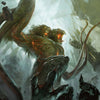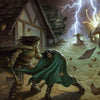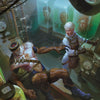Top 7 D&D Magic Item Mistakes

I get it, I do. Magic items are awesome in Dungeons & Dragons. Your players love them, and you enjoy homebrewing them.
However, it’s important for us to consider WHAT makes a good magic item, because by doing so, we avoid magic item flops, and make our games even better. So, today we’re going to be examining the top seven mistakes game masters often make when designing magic items.
By the way, if you’re a busy game master looking to reduce your prep time, we got your back. Every month my team and I publish a new issue of Lair Magazine loaded with 5e and Pathfinder 2e encounters, adventures, monsters, puzzles, traps, maps, and other resources you can use in your gams. Everything is designed to be dragged and dropped into your existing campaign, too!
Watch or listen to this article by clicking the video below.
#1 Power, unlimited power!
The Amulet of Infinite Wishes. Not only do you have infinite wishes, but you’re also immune to all damage types. Shoot, this should be called the Amulet of Godhood. If you ever manage to get your hands on this, I 100% guarantee you every deity in the multiverse will be tracking you down… I wouldn’t be shocked if something like this already actually exists.
This is probably the number one mistake I’ve observed with homebrew magic items. They’re just crazy powerful. It almost like the magic items in the book were just SO lackluster that we just had to SPICE THINGS UP. Browse through D&D Beyond or Reddit, and chances are you’re going to find all sorts of OP magic items. Cantrips that can heal—oh wait, that’s a spell—okay, fine, rings of regeneration that heal 50 hit points a round.
Now, I’m guessing that the majority of these OP magic items we might find were created by folks who just aren’t super familiar with the game design and mechanics of whatever system they happen to be using—D&D, Pathfinder, etc. So, they are created more out of ignorance than intentional choice. And that’s understandable. You don’t know what you don’t know.
However, I’m sure there’s a segment of people who create OP magic items and justify it by saying that magic items should be COOL and AWESOME. And creating another meh magic item just doesn’t do it for them. In other words, they want to play a high-powered game where characters wield the power of demi-gods, and magic items are part of that. Now, there’s nothing wrong with playing that sort of game if you want to, as long as you walk into it with your eyes wide open.
Be aware that by introducing super powerful magic items that you are throwing askew many to most of the game design assumptions that go into the core rules of your system. This means you’re going to have to adjust more than just the magic items. If there’s an encounter building mechanic—such as D&D’s challenge rating system—that’s not going to work much at all any more…not that it was super great to begin with, but that’s beside the point.
Other systems such as Pathfinder 2 have really tight encounter building systems, and those will be borked. You’ll probably find a ripple effect across various game mechanics when you introduce super powerful magic items. And that means you’ll either have to ACCEPT those consequences, or get under the hood and try to adjust those mechanics as well. And if you’re cool with either of those routes, then rock on.
But if you want to save yourself more effort and unintended consequences, it’s far easier to keep the power level of magic items under control. You can still have a magic item do something cool without it being game breaking. One simple technique that helps you do this is to have FEWER magic items in your games. You see, when the characters don’t have 7 bags of holding full of all the magic items you’ve dolled out, magic items tend to be much more special to the players. And each one they get IS super cool because, well, they just don’t have that many of them.
#2 Everything including the kitchen sink!
The Cloak of Endless Abilities. This multi-colored cloak shimmers with an ethereal light and seems to change its appearance slightly every time it's looked at. The cloak grants a wide array of abilities to its wearer: elemental control, shape-shifting, teleportation, mind control, invisibility, healing, flight, true sight, AND MORE! And now through Sunday, you can get 50% off. Link below!
This pitfall involves stuffing a magic item with tons of abilities, effects, spells, and the like. Now, sure this will probably increase its power level, pushing us into the mistake we just mentioned, but the OTHER THINGS it does it make the magic item more complex, mechanically speaking. And that’s a problem.
You see, this brings us back to the age-old conundrum that something that looks good on PAPER doesn’t always work well IN PRACTICE. And when you have a super complex magic item, this is what happens at the game table.
“Um, I want to use my Staff of 101 Useful Effects. Um….well…I could do this, or that, or….”
And then the other players start jumping in with suggestions, and then the entire table is dissecting the best possible use for THAT ROUND in combat, let alone all the others. Even if you don’t end up with this sort of committee discussion that can turn every turn into a slog, the player is still going to struggle with either deciding WHAT to do or with HOW the magic item works, because you made the thing too darn complex.
Generally speaking, magic items should be simple and straightforward. Yes, there is a time and a place for some complexity, but those should be reserved for the truly special magic items characters come across, such as artifacts and the like.
This is where that KISS acronym comes in handy. Keep It Simple Stupid. Oh crap, I think we’re not supposed to use that anymore. Oh, well, OH! Keep It Simple Steven. How’s that? Oh crap, now I just called out everyone named Steven… Geesh… Help me out guys, what does KISS stand for these days? Can we still use that acronym? Do we have a different one now?
#3 Rarity, what’s rarity?
Sword of Planar Rifts. This longsword has a blade that seems to shimmer with a spectral light, its edge appearing to slice through the very fabric of reality. Abilities include planar strike, rift walk, and banishing slash. In the hands of a level 15 group, sweet. Now they can track down those githyanki and extract justice…and revenge. But at level 3? But I bet you have been in a group that’s done something like that before, haven’t you? How did it turn out?
Whether your game system uses rarity such as D&D 5e or item level such as Pathfinder 2, doesn’t matter so much as the PURPOSE behind such systems, and that’s to govern when magic items should be introduced to the game. For instance, in D&D a rare items shouldn’t be introduced until level 5 or higher, and a very rare until level 11 or higher. And my point here is that when you are homebrewing a magic item for your level 2 group, you should strive to create an item that is appropriate for their level. We already went off the deep end ranting about OP magic items, however the group’s level has a big say in determining whether something is OP or not.
For instance, the D&D game I’m currently running for my Ancient Dragon patrons is level 18—about to be level 20 once they take downtime and pick up the 2 levels they have waiting for them—and I have very little reservations about sprinkling uncommon and rare magic items into the game. I know at their level they will likely do little to shift the balance. However, I must still be careful with very rare and especially legendary items. Too many of those, and I might have issues.
#4 Weapons galore & murderization!
Starfire blade, whisperwind bow, frostreaver axe, Shadowstalker Dagger, Sunburst Warhammer, Tempest Glaive, Crimson Fang Rapier, Thunderclap Maul, Voidheart Staff, Mirage Spear… Okay, when is enough magical weapons enough? I know we all love murdering ourselves some innocent goblins minding their own business in their cave whenever we get a chance, but at some point it’s overkill, isn’t it?
The next pitfall with homebrewing magic items is focusing only on combat, whether that’s making everything a magic WEAPON or giving magic items properties that are only useful in combat—it doesn’t matter. Make sure you’re creating items that the players will find useful in the other pillars of the game, such as exploration and social interactions. This will make them more exciting for characters because they’ll both have more VARIETY but be able to use their cool stuff in more parts of the game. It also helps you develop and include all three pillars of the game to a greater degree. And if you’re not familiar with the three pillars of a roleplaying game, be sure to check out my video on the 3 Pillars of a Successful D&D Game.
Also, beyond the purpose of a magic item, consider including different item TYPES, such as weapons, wands, staffs, wonderous items, armor, rings, scrolls, etc. Remember, too, that not everything should be a permanent magic item; include consumables as well. And if you’re already homebrewing, you could make a piece of armor have a property that only works 3 times and never recharges. Same for wands, staffs, etc.
#5 So, why do we want this again?
The Ring of Pebble Detection. This simple copper ring is adorned with a small, unremarkable quartz crystal. When worn, the ring hums softly in the presence of small pebbles. Gee, thanks, Mr. Dungeon Master, this is going to come in super handy.
Clearly that’s a silly example, something I hope and pray doesn’t actually exist, but the point is that if you’re spending the time homebrewing a magic item, you might also want to make it relevant to your campaign. If you never plan to have any demons, don’t give the players a helmet of fiend protection. Furthermore, if you can work the theme or plot of your campaign into the design or origin of the magic item—or a character’s backstory—even better.
Again, you’re taking time to make the darned thing, you might as well make it really FIT into your campaign, make sure that characters will find it useful, and ensure that players will ACTUALLY WANT IT. Nothing smarts more than spending lots of time creating a thing only to have the players toss it over their shoulder and walk away.
#6 So, what does this do exactly?
The Orb of Transmutation. Once per day, at a time that is neither night nor day, this orb when held at precisely the right height, will transform its target into something of your choice.
What, is the casting time a riddle? When can I actually use it? What’s the right height I need to hold it? And why does that even matter? Can the target be a creature, or just an object? Does the object have to be unattended? Can I turn it into ANYTHING? Like, even a clone of myself that is completely loyal and obedient? Am I going to have a clone army now? Are you like my father now?
Okay, yes, I know that you’re going to be RIGHT THERE when your players begin to pepper you with 21 questions, and, yes, you can resolve any doubts right then. But do yourself a favor and try to figure out the big stuff in advance. You want a magic item whose powers are clearly defined and easy to understand.
Another pro tip I can give you is to clearly label all your homebrew magic items as ALPHAS with a note that they might be modified during gameplay as needed. After all, you’re never going to know if you came in too hot or too cold on a magic item until it gets used in gameplay. So, make sure your players understand you reserve the right to modify it as needed; setting this expectation can avoid lots of pain.
#7 But, we can already do that…
Amulet of Common Speech. This simple amulet is made of bronze and bears the symbol of an open mouth. It grants the ability to speak and understand Common.
Okay, now maybe, JUST MAYBE, this might be useful if the characters give it to a creature they run across that can’t communicate with them—actually, that’s probably a pretty darn good magic item, now that I think about it. Especially, if it doesn’t require attunement.
Okay, bad example, but it’s been a long video, okay, so cut me a break. Just USE YOUR IMAGINATION okay, and pretend that the magic item replicated abilities that the group already had and thus had no need of.
Because, my point here is that when you introduce a new magic item, it should ideally bring something new to the table. It should be a spell, or ability, or effect that the group will not only find useful but also add a new dimension to gameplay. Maybe they couldn’t fly before, but now they can.
Or the stupid monk REFUSES to carry ranged weapons, so their being able to fly makes them a bit less useless, because, let’s be honest, 5e monks are pretty pathetic for the first half of the game, aren’t they? And then they turn into powerhouses. Let’s make a class where the player can SUFFER through one year of gameplay, and then feel TOTALLY VINDICATED and rub it in the other players’ faces. NOICE!
Get that Homebrew Feel without Hours of Work!
Now, if you’re a dungeon master who loves homebrewing, you probably spend lots of time head down doing just that for your 5e or Pathfinder 2e game. However, you probably don’t have enough time to homebrew EVERYTHING for your game.
And that’s exactly how Lair Magazine can help; get that homebrew FEEL without hours of prep. You see, every issue of Lair Magazine contains a variety of 5e and PF2e resources that you can just drag and drop into your game: things like adventures, one-off encounters, monsters, traps, puzzles, and yes, even magic items.
Furthermore, my team and I design Lair Magazine content to make your game easier and faster to prep. From eloquently written read-aloud text, to area descriptions, to roleplaying and encounter notes—everything in Lair Magazine is designed to make running your 5e or Pathfinder 2 game easier!
Reduce some of the frustration and effort of being a game master. Check out all the Lair Magazine issues available here, and get more bang for your buck with the Lair Magazine bundles!
-
Posted in
Game Master How-To Articles







